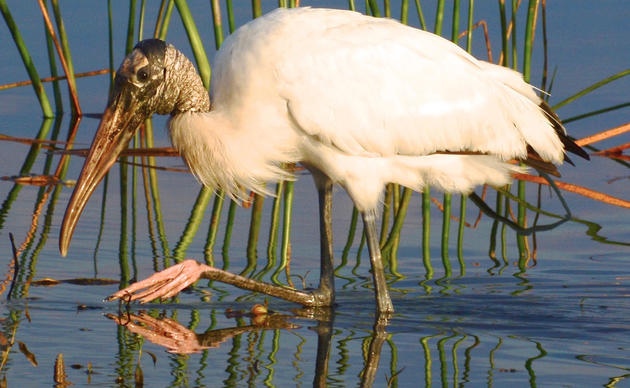A Corkscrew Swamp Sanctuary-inspired work of art is currently on display at the Baker Museum in Naples. Morning Walk at Corkscrew Swamp Sanctuary is part of Botanical Revolution, a solo exhibition from Tamara Kostianovsky, a Brooklyn-based Latinx artist whose connection to and fascination with the natural world is clear in her work.
You created Morning Walk after visiting Corkscrew Swamp Sanctuary for the first time during a trip to Naples. Can you share more about your visit?
I am grateful to Artis Naples for having invited me early on to do a research trip to the area in preparation for my exhibition at the Baker Museum. I visited the Botanical Gardens, accompanied by a birder and a biologist, a beautiful experience. We didn’t see as much fauna as I was expecting (it was January), but it was moving to hear my guides speak with so much devotion to this land, its flora and fauna. I got a lot out of my experience walking alone one morning down Corkscrew Swamp, where after being initially frustrated for not seeing any birds along my path, I was surprised by an egret perched over the branch of a tree right above me. This visitor pointed me in the direction of what I assume was his family, a happy flock taking a bath in the stream under the boardwalk. It was lovely and unexpected, the egret got close to me, and I was able to take many photos. Later, I included egrets in the work specifically made for this exhibition.
You grew up in Argentina and moved to the U.S. to attend art school. Did you spend a lot of time in nature growing up? How did that change after moving to the U.S.?
I grew up in the center of Buenos Aires and have been living in New York for the past 22 years. I do live a very urban life and my contact with the natural environment is sadly quite sporadic. My father was a surgeon, and, through his practice, I became aware of a world behind the skin, where veins exploded into waterfalls, severed ligaments set free the muscles they once contained, and chunks of fat poured over tissues of various colors and textures. A fascination with these scenes put the torn body at the center of my work, and as time went on, I continued using this imagery to reflect on violence, consumption, ecology, and the voracious needs of the body. My obsession with the wounded body in the era of environmental crisis prompted me to transpose my specific interests to the natural landscape. That’s how I became interested in dead birds and tree stumps, which are also a type of carcass.
You currently live in Brooklyn, New York. How do you connect with nature in your daily life in a big city?
I try to take trips to Upstate New York and other places where nature is prevalent. I am particularly interested in urban nature, so it isn’t so hard for me to get inspired. Sometimes an item in a market or a cut down tree on the sidewalk can spark something in me that I can bring to my studio. I also make a point of often visiting the urban parks of New York, where I find, among other things, interesting dead trees that become feeding logs that support new life. Just the other day, I saw an uprooted tree with polypores that left me speechless.

How do you think art can play a role in conservation?
I make trees and birds using discarded textiles, a very human material. Part of the point is to create environments out of the same materials that clothe our bodies, showing a common nature among all living things. It is my hope that viewers see the nature I represent not as something apart from themselves but as an extension of their bodies. Perhaps by making that connection, conservation efforts can advance.
See Morning Walk at Corkscrew Swamp Sanctuary and the rest of Kostianovsky's Botanical Revolution at the Baker Museum through April 7. Learn more.




